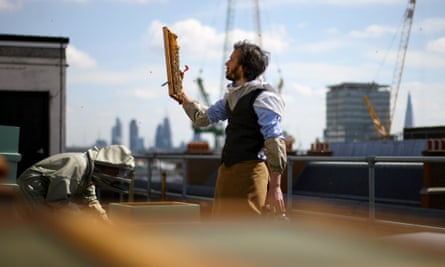I love bees. Everyone I know loves bees. And everyone knows bees are on the decline. But could it be that cities will come to their rescue? That question has fascinated me since I first came across the Insect Pollinators Initiative (IPI), a nationwide research collaboration with the singular aim of exploring the lives of bees and other pollinators.
Digging deeper into the IPI’s various projects, I discovered the Urban Pollinators Project – a research collaboration spread across nine cities in the UK that wants to find out as much as possible about the pollinators that are gradually moving into our cities. These, after all, form the bedrock of our food supply wherever we live, and their absence would leave our daily diets drastically impoverished.
We are, unfortunately, used to hearing about “bee decline” these days, but the term is usually reserved for honeybees – alongside “hive collapse”. The IPI, however, talks of bee decline in far greater brush strokes. It turns out that, alongside honeybees – the only bees that actually make honey - and bumblebees (pretty much the extent of my bee trivia prior to making this film), there are more than 250 species of wild and solitary bees living among us: in trees, unused mouse holes, bricks and hotels. More on the hotels later. And increasingly, they’re moving into urban environments.

As Jane Memmott, an ecology professor at Bristol University, explained to me, humans are spreading – and we have a large bootprint. More people means more houses, bigger cities, a bigger burden on the food supply and so more farming. The flipside of this is that bees and other pollinating insects are being progressively squeezed from their natural homes. Pockets of rural green are diminishing in direct response to the spread of concrete. Add to loss of habitat the threats of insecticide and the goliath that’s global warming and cities are looking increasingly useful places to live.
One of the saddest things I discovered was the impact global warming is having on our pollinators. Imagine you’re a bee. You’ve spent winter in your tiny underground nest, safe. The light levels change, signalling the arrival of spring and out you come, hungry – but there’s no food. Climate change has affected the temperature, so what should be a blossoming garden is still a raft of tight buds. The end.
Cities are naturally a little warmer than unsheltered land. They also have a huge diversity of food to be found in the flowers of nature reserves, gardens, allotments, cemeteries, road verges, pubs, parks, car parks – all of which are becoming increasingly necessary for wild bees to survive. That patch of weeds in the corner of the car park? That’s a café for local solitary bees. Those tufts of lavender planted on the traffic circle are a haven for bees, butterflies and anything else caring to join them.

What really struck me was the interdependence of it all. Cities, as they are, are probably OK for bees; certainly better than nothing. But if we collectively do a little more to help pollinating insects, the rewards could exceed our most optimistic expectations.
Take bee hotels – nothing more complex than a small shelter with cardboard tubes. Each of these little tubes is space for a solitary bee, a place where it can rest and shelter, preferably in your garden. Until a few months ago I’d never heard of them, now every person I mention a bee hotel to wants to get one for their friend’s birthday. And by taking more care to plant bee-friendly flowers in our gardens and flowers that blossom throughout the whole year (most gardening centres highlight them), we can guarantee that bees have something to keep them going while they pollinate, flourish and grow in numbers.
Nature, the master strategist, has decreed what’s good for bees is also very good for us. The ultimate goal, then, is to incorporate the spirit of bee friendliness into the very fabric of urban planning – to make the spaces in which we humans live as welcoming and nourishing as possible for our winged neighbours. By doing so, cities will become greener, more spacious, more social, more friendly and alive.
Read the full version of this article at Mosaic: the Science of Life, a digital publication from the Wellcome Trust. It is reproduced here under a Creative Commons Attribution Licence.
Comments (…)
Sign in or create your Guardian account to join the discussion